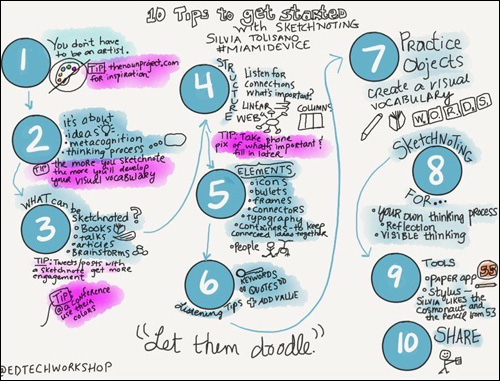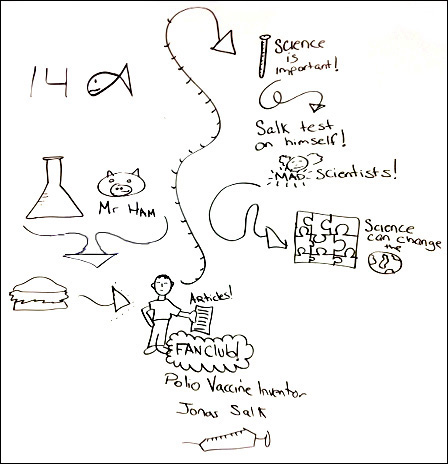
Use visual note taking to build understanding

Were you one of those students who always reached for a pen while listening to teachers or classmates? If so, you likely also remember being told to “stop doodling and pay attention!”
Thankfully, students today are far less likely to be chastised for doodling, and in many classrooms learners are being taught how to doodle purposefully as a way to record and internalize the salient points of a lesson.
This purposeful doodling is now referred to as sketchnoting, and it is now considered a useful technique to support information recall and build understanding.
In Sketchnotes 101, author Craighton Bermandescribes sketchnotes as “visual notes that are drawn in real time.” By drawing pictures of what they are hearing, students’ minds are engaging multiple modalities, often leading to increased retention of information. In Visual Note-Taking for Educators, author Wendy Pillars writes that sketchnoting or ’edusketching’ — can improve retention by up to 55%.
In this video, my fifth-grade student Samantha explains how doodling engages “all four ways learners learn: audio, visual, reading/writing and kinesthetic.”
Sam's TED ED Talk from MJGDS Classrooms on Vimeo.
I can imagine the protestations many of you have, so I will reassure you in advance: you do not need to be able to draw to introduce sketchnoting to your students! Sketchnoting isn’t about art. The important concepts, shares Silvia Tolisano, are “ideas, connections, thinking, about the process, visualizing and organizing your thinking.”
Although I don’t consider myself a natural artist, I was fascinated by the visual notes other people take and decided to learn to sketchnote. I also wanted to understand the process so I could help my 4th and 5th grade students add this technique to their toolkit of learning strategies.

Anxiety about my artistic shortcomings, coupled with a lack of personal experience with the process, left me wondering how to give my students the best possible experience, so I reached out to art teacher Shana Gutterman for ideas about implementing this style of note taking.
We began by having students watch Claudine Delfin’s Sketcho Frenzy: The Basics of Visual Note-taking. Shana then modeled the process by creating a sketchnote on the classroom whiteboard as I read aloud a chapter from a book my class is reading.
Despite being a skilled artist, Shana had never taken visual notes before. She was surprised at how natural it felt and found herself “thinking as I was drawing and retaining more information from the chapter than I would have if I just listened.”
Next, we distributed paper and colored pencils and asked the students to try sketchnoting. While some students preferred careful listening to sketchnoting, many loved the strategy and asked to be allowed to sketchnote during read-aloud time in class.

Many of my students who continued to sketchnote elected to use Wixie and other digital tools available in my classroom. Students also used sketchnoting during listening activities such as Skype calls with experts and with students in other classrooms.
I was delighted to see that many of the students who struggled to some degree with recall or other areas of listening comprehension were drawn to sketchnoting. Their sketchnotes aided them with writing assignments and appeared to enhance their enjoyment of listening.
We live in a visual world. We all learn differently and demonstrate mastery in unique ways. Though many of us do not feel artistic, giving students opportunities to express their ideas visually using sketchnoting provides them a powerful strategy they can use to take ownership of their learning.

Follow us on Instagram for daily inspiration

Create a thought web, cluster, flowchart, or other graphic organizer for a lesson
8 first projects to get students using technology
Creative, digital book reviews
Fun and powerful ideas with animated characters

Wixie
Share your ideas, imagination, and understanding through writing, art, voice, and video.

Rubric Maker
Create custom rubrics for your classroom.

Pics4Learning
A curated, copyright-friendly image library that is safe and free for education.

Wriddle
Write, record, and illustrate a sentence.

Get creative classroom ideas delivered straight to your inbox once a month.
Topics